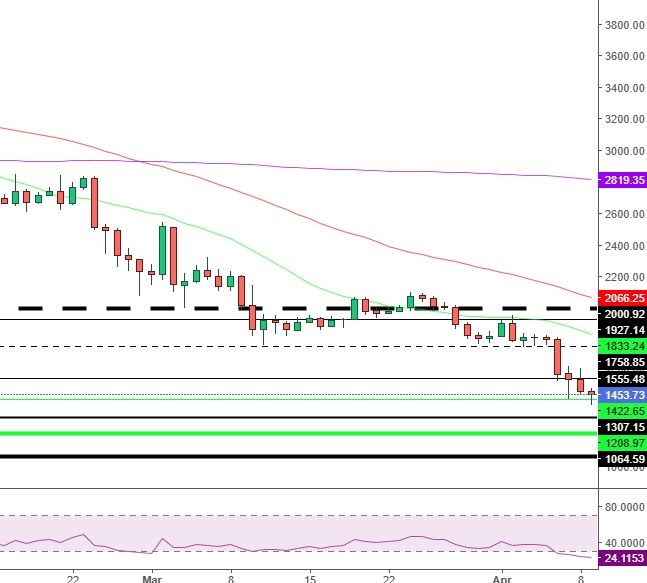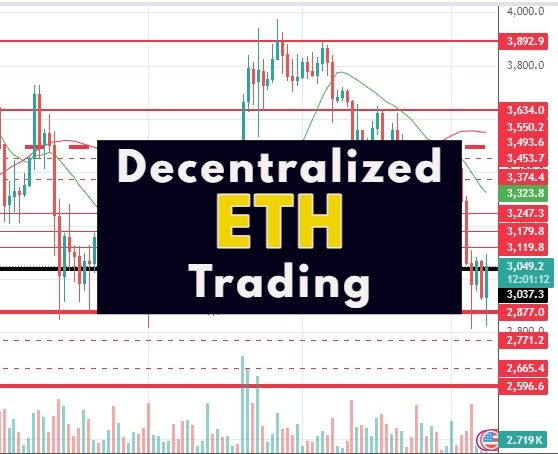Decentralized Ethereum (ETH) Trading. Discover the price zones to watch and the advantages of decentralized trading.
Decentralized Ethereum (ETH) trading, an excellent way to profit from and trade the rise and fall of the ETH price. Discover the advantages of decentralized ETH trading.
Decentralized Ethereum (ETH) Trading – the advantages:
Decentralized trading of Ethereum (ETH) is gaining traction in the digital finance world. Unlike traditional centralized trading platforms, decentralized exchanges (DEXs) offer a new way to trade digital assets, emphasizing transparency, security, and user autonomy. This article explores the key advantages of decentralized ETH trading.
1. Enhanced Security
Resistance to Hacks
DEXs operate without a centralized intermediary, significantly reducing the risk of hacking. User funds are not stored on a single platform but remain under the control of the owners in their private wallets. This structure minimizes vulnerabilities that hackers often exploit to attack centralized platforms.
Use of Smart Contracts
DEXs rely on smart contracts, autonomous programs executed on the blockchain. These contracts ensure the automatic and secure execution of transactions, eliminating the need for trust in a third party. Ethereum’s smart contracts are known for their robustness, further enhancing the security of exchanges.
2. Transparency and Verifiability
Open Source
Decentralized platforms are often open source, allowing anyone to audit the code. This transparency builds user trust, as the code can be reviewed to identify and fix potential vulnerabilities.
Blockchain Record
All transactions conducted on a DEX are recorded on the blockchain, providing complete traceability. Users can verify the history of all transactions, increasing transparency and reducing the chances of manipulation or fraud.
3. Autonomy and Control
Private Key Management
In a DEX, users retain control of their private keys. This autonomy prevents fund losses due to bankruptcies or malicious behavior by a centralized platform. Users are solely responsible for managing and securing their assets.
Global and Uninterrupted Access
DEXs operate without interruption, regardless of local regulations or technical issues with a central server. They are accessible at any time and from anywhere, offering greater freedom for traders worldwide.
4. Reduced Fees
Transaction Fees
Centralized exchanges often charge significant fees for transactions and withdrawals. By using a DEX, users can benefit from lower transaction fees, as there is no intermediary to charge additional fees.
No Deposit and Withdrawal Fees
DEXs allow users to deposit and withdraw funds directly from and to their private wallets without additional fees, which can represent significant savings, especially for frequent traders.
5. Diversity of Assets
Wide Range of Tokens
DEXs often offer a greater variety of tokens compared to centralized exchanges, including lesser-known or newly launched tokens. This diversity allows traders to find unique investment opportunities.
Quick Addition of New Assets
New tokens can be listed on DEXs much faster than on centralized platforms because there is no centralized approval process. This allows traders to access new market opportunities quickly.
Conclusion
Decentralized ETH trading offers numerous advantages over centralized platforms. Enhanced security, increased transparency, user autonomy, reduced fees, and asset diversity are among the key benefits attracting more and more traders to this new form of exchange. As the decentralized finance (DeFi) ecosystem continues to grow, DEXs play a crucial role in democratizing and securing cryptocurrency trading.
This generally impacts the ETH price:
Upcoming updates: The Ethereum network continues to evolve with updates such as the Shanghai update, which allows stakers to withdraw their ETH. These updates can influence market sentiment and the ETH price. Events such as a new ETF linked to ETH also influence the price.
Global economic factors: General economic conditions, including regulatory developments and macroeconomic trends, will also have an impact on ETH performance. Investors should keep a close eye on global economic news as well as the latest crypto news.
Technical analysis: Current technical indicators suggest bearish sentiment, with a significant level of market fear. However, some analysts foresee a potential rebound if key support levels are maintained. Find out more below.
Decentralized Ethereum (ETH) Trading – technical analysis (daily)

Here’s a technical analysis of Ethereum (ETH) based on recent price movements, key support/resistance levels, and overall market sentiment:
Ethereum (ETH): Technical and Fundamental Analysis
Technical Analysis of Ethereum
Current Market Overview
-
Current Price: $1,480.84
-
Daily Change: -$88.02 (-5.61%)
-
Intraday Range: Between $1,397.75 and $1,586.90
-
Overall Sentiment: The market is leaning bearish, with notable selling pressure.
Technical Indicator Insights
Moving Averages (MA)
-
20-Day MA: Positioned above the current price, acting as short-term resistance.
-
50-Day MA: Also above the price, confirming the ongoing downward trend.
-
200-Day MA: Significantly higher than current levels, signaling an extended correction phase.
-
Key Insight: A breakout above the 20-day MA could indicate a shift in trend momentum.
Relative Strength Index (RSI)
-
Current Level: Around 35, reflecting continued downward momentum.
-
Signal: A drop below 30 would signal oversold conditions, potentially marking a buying opportunity.
MACD (Moving Average Convergence Divergence)
-
Setup: The MACD line is below its signal line, suggesting bearish momentum.
-
Histogram: Displays waning selling strength, hinting at a possible consolidation period.
-
Watch for: A bullish divergence may point to a trend reversal on the horizon.
Key Levels to Watch
Resistance Levels:
-
$1,500: Immediate resistance; a breakout here could open the path toward $1,600.
-
$1,650: A decisive breach may push prices toward $1,800.
-
$1,800: A significant barrier tested in the past.
-
$2,000: A major psychological level—clearing it could spark a strong rally.
Support Levels:
-
$1,400: Recent short-term support.
-
$1,300: A critical level that, if broken, may trigger further downside.
-
$1,100: Strong foundational support in case of intense selling pressure.
Personal Stance
Note: This is not financial advice—just my personal market view.
From a long-term perspective, Ethereum continues to present compelling fundamentals. However, short- and mid-term uncertainty keeps me cautious. Personally, I’m only looking to engage at strategically favorable levels (marked in green on my chart).
Outlook: What Scenarios Are in Play?
-
Bearish Case: A drop below $1,400 may lead to further declines toward $1,300 or even $1,100.
-
Bullish Case: A rebound above $1,500 followed by a breakout past $1,650 with solid volume could send ETH toward $1,800.
Current Trend Assessment:
-
Short-Term Trend: Bearish
-
Medium-Term Trend: Neutral
-
Long-Term Trend: Bullish, as long as ETH remains above $1,100
Key Focus Areas: Track trading volumes and how price reacts at critical levels like $1,400, $1,500, and $1,650.
Fundamental Analysis: What Could Push ETH Higher?
Despite current consolidation, Ethereum has several potential tailwinds that could drive growth in the coming months.
Growing Adoption of Layer 2 (L2) Scaling Solutions
Projects like Arbitrum, Optimism, and zkSync are gaining traction rapidly. By making Ethereum transactions cheaper and faster, they’re significantly increasing user activity on the mainnet and boosting demand for ETH used in gas fees.
Staking Demand – Still Strong, But Evolving
As of February 15, 2025, roughly 33.5 million ETH were staked, representing 27.6% of the circulating supply—a slight decrease from the November 2024 peak of 29%. This suggests shifting investor sentiment. Furthermore, Lido controls about 69% of the liquid staking market, raising concerns around centralization risks in Ethereum’s validator landscape.
Macro Conditions May Provide Tailwinds
As central banks begin easing monetary policy—including potential interest rate cuts—risk assets like cryptocurrencies may become more attractive to investors seeking yield and growth.
Clearer Regulations Could Attract Institutions
If regulators in the U.S. and EU classify Ethereum as a commodity rather than a security, it could unlock substantial institutional interest and new capital inflows.
Conclusion: Where Could ETH Be Headed?
Ethereum is currently at a crossroads. A sustained move above $1,500 may signal the start of a bullish reversal targeting $1,800 or even $2,000. On the flip side, a breakdown below $1,400 would likely shift the focus to lower support zones like $1,300 or $1,100.
Price predictions for 2025 vary widely. For instance, Standard Chartered recently revised its target to $4,000, while other analysts are forecasting even higher levels.
⚠️ Disclaimer: This content is for informational purposes only and does not constitute financial advice. Always consult a financial advisor before making investment decisions.
Correlation with Bitcoin
- Monitoring Bitcoin’s performance is essential for predicting ETH’s price movements. For more detailed analysis, refer to: decentralized Bitcoin trading.
Find out now by testing a decentralized trading platform and make up your own mind.
Direct access to decentralized ETH trading
Community of experienced traders in the Forex, commodities and crypto markets, offering articles to help you learn about trading through: relevant information – technical and fundamental analysis. Specificity: specialized in decentralized trading.
Communauté de traders expérimentés sur les marchés du Forex, matières premières, cryptos, offrant des articles permettant de s’éduquer au trading à travers : information pertinente – analyse technique et fondamentale. Spécificité : spécialisé dans le trading décentralisé.
